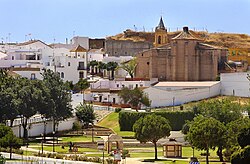Palos de la Frontera
| Palos de la Frontera, Spain | |||
|---|---|---|---|

Panoramic view of downtown Palos de la Frontera
|
|||
|
|||
 Location of Palos de la Frontera |
|||
| Province | Huelva | ||
| Government | |||
| • Mayor | Carmelo Romero Hernández | ||
| Area | |||
| • Total | 50 km2 (20 sq mi) | ||
| • Land | 50 km2 (20 sq mi) | ||
| • Water | 0.00 km2 (0.00 sq mi) | ||
| Population (2015) | |||
| • Total | 10,365 | ||
| • Density | 208.28/km2 (539.4/sq mi) | ||
| Demonym(s) | palermos (m.), palermas (f.) | ||
| Time zone | CET (UTC+1) | ||
| • Summer (DST) | CEST (UTC+2) | ||
| Website | http://www.palosfrontera.com/ | ||
Palos de la Frontera (Spanish pronunciation: [ˈpaloz de la fɾonˈteɾa]) is a town and municipality located in the southwestern Spanish province of Huelva, in the autonomous community of Andalusia. It is situated some 13 km (8 mi) from the provincial capital, Huelva. According to the 2015 census, the city had a population of 10,365. It is most famous for being the place from which Columbus set sail in 1492, eventually reaching America.
The official date of foundation for Palos is 1322, when the town was granted to Alonso Carro and Carro's wife Berenguela Gómez by Alfonso XI of Castile, although the town may have been occupied during earlier centuries by Paleolithic, Tartessian, Roman, Visigothic, and Muslim inhabitants. Palos' name is derived from the Latin word palus (“lagoon”). It acquired its “surname” as Palos de la Frontera in May 1642.
At the time of its establishment as a town by Alfonso XI, Palos was part of the Almohad kingdom of Niebla, and was a small nucleus whose population subsisted on fishing and took advantage of the area’s geographic protection against pirates and storms.
Álvar Pérez de Guzmán is considered the city’s real founder. He was only fourteen when Juan I of Castile granted him the towns of Palos and Villalba del Alcor in 1379 to make up for the fact that Pérez de Guzmán was forced to give up Huelva and Gibraleón, which had become part of the county of Medinaceli. Álvar Pérez de Guzmán received from Juan I the right to tax the first fifty families who settled at Palos, and he began utilizing the lands around Palos for the cultivation of olive trees and production of olive oil. After the death of Álvar Pérez de Guzmán, his widow, Elvira de Ayala, daughter of the Chancellor of Castile, continued her husband’s work until her death in 1434.
...
Wikipedia


